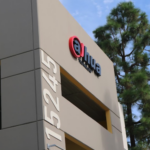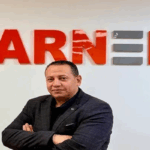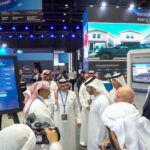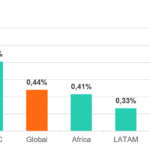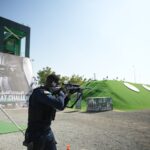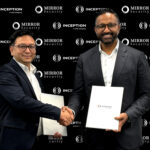Interview: Alex Lapirov, CEO, Microavia

We saw an overwhelming demand for UAVs in GCC and moved our operation to Dubai. This opened a whole new pool of talented engineers for us and the possibility of working closely with organizations throughout the MENA region. We pride ourselves on producing and developing most of our hardware and software in-house. This can be challenging, but the result is top-notch quality of both products and services.
Interviewer: Damir Muharemovic; E-mail: editorial@mideast.com
a&s Middle East: Could you please present yourself to the readers of the a&s Middle East?
Lapirov: I am Alex Lapirov, a seasoned business development expert and leader. I hold a master’s degree in international and intercultural communication, complemented by various other courses. Before joining Microavia, I held a variety of senior sales and executive positions, including Sales Director CIS at Oracle and CEO of WinterArk. I am deeply involved in many processes at Microavia, supporting the team to innovate and rapidly bring new products to market.
a&s Middle East: What are your core areas of expertise as the UAE’s first and only drone manufacturing company? Tell us more about how and when it started for Microavia and some critical milestones.
Lapirov: Microavia is the leading GCC drone innovation and manufacturing company. With almost 100 employees from 12 different nations, we develop and produce industrial drones for various commercial applications. We are also one of the few companies in the World providing managed drone infrastructure as a service (MDIaaS). Our headquarters are in Dubai Silicon Oasis.
The company started in Europe two years ago with a mission to manufacture advanced UAVs for communications and monitoring. However, two years ago, we saw an overwhelming demand for UAVs in GCC and moved our operation to Dubai. This opened a whole new pool of talented engineers for us and the possibility of working closely with organizations throughout the MENA region. We pride ourselves on producing and developing most of our hardware and software in-house. This can be challenging, but the result is top-notch quality of both products and services. It is possible because of our talented people – avionics engineers, quality and assembly experts, AI vision programmers, and the customer support team.
a&s Middle East: Tell us more about your latest drone platform. Why is it, as you market it, “ideal for industrial applications”? And what are its security applications?
Lapirov: Microavia has developed three distinct drone lines, which are meant to satisfy most of the customer’s needs. Ortus Dock is a drone-in-a-box solution with a robust drone dock serving as a recharging and data exchange station for the drone. It has four batteries, which can be swapped automatically, and climate control inside. If Ortus Dock has a power supply, drones can land and go on missions 24/7.
Ortus Kite is the tethered version with a winch with a power cable. The drone can hover at an altitude of up to 200 meters indefinitely, providing 24/7 monitoring with a live video stream.
Last but not least is our heavy-duty Fortis drone, which is most commonly used for geophysical surveys. It can carry up to 20kg of payload for extended periods and has some unique features helping stabilization and terrain following.
All our drones are managed through our proprietary flight management system (UTM), which is heavily focused on allowing automated mission planning and execution and AI assistance.
a&s Middle East: What kind of cameras, sensors, lights, and other technical systems is it equipped with? Does it come as standard equipment, or does it depend on a specific industrial application?
Lapirov: We have developed a very flexible gimbal, which can be used with various payloads and adjusted to customers’ needs. That said, we also have a set of “standard” equipment, which we usually ship: video, photo, and thermal cameras, which are all developed by us. Then there are two additional options, which our partners create for us: a LiDAR for surface point cloud scanning and a magnetometer, which is used for mineral surveys.
a&s Middle East: Ortus Dock is autonomous by design. What does this ability imply, and what are the specs of Microavia land spots where it recharges?
Lapirov: Our engineers love numbers, and there’s always a celebration when they improve one of them. I think some of the critical numbers are the following. It takes less than 1 minute for the Ortus drone to take off from the dock, following the mission starts command. This is crucial for emergency response. Battery swapping takes about 90 seconds, which means minimal downtime for continuous operations. A single Ortus Dock can cover an area of ca 1000 sq km, depending on the payload.
a&s Middle East: You can manage drone operations differently, from gathering geo and aerial data and mission planning to automated flight modes and risk assessment. What are the features of the Microavia drone operation management, and can you scale your operations to hundreds or even thousands of drones?
Lapirov: The key differentiator is our proprietary UTM. It can comfortably handle unlimited drones thanks to the extensive mission planning functionality. A customer can quickly scale any number of Ortus Docks to provide mission capabilities over large areas. Our software is cloud-based, meaning drone operators can be thousands of kilometers away from the drone and still execute missions and analyze the results. Also, our docks can be chained, meaning that a single drone can travel between multiple docks for battery replacement while keeping the monitoring missions going. This effectively doubles the flight range.
a&s Middle East: Your manufacturing processes mostly rely on your capacities. Since robotics technology is increasingly sophisticated, how do you plan to maintain that kind of independence of third parties?
Lapirov: Initially, we relied heavily on 3rd party components but quickly realized that this affected the reliability. So, our engineering leads have put their heads together and made a list of priorities for in-house production vs. what we have to order outside. As a rule of thumb, software and most of the assembly is made by us down to autopilot components. We have two manufacturing areas to satisfy the demand and will likely keep expanding.
a&s Middle East: How do you make your products fit increasingly rigid standards and regulations imposed by UAE national regulatory authorities?
Lapirov: Drone regulations are relatively new, both in UAE and globally. The main concern areas are the so-called BVLOS flight (Beyond Visual Line of Sight) and pilot competencies. Developing these regulatory frameworks takes a lot of time, as civil aviation and transport authorities must coordinate with law enforcement and the military. The UAE situation is even more difficult because drones have been used in terrorist attacks. On our end, we work with authorities to promote the responsible usage of drones. However, this process is long and tricky as Microavia operates in many countries. Thankfully, our partners in various countries fully support this work.
a&s Middle East: Last year the Seed Group teamed up with Microavia. What have you achieved in that collaboration since its announcement?
Lapirov: We are very grateful that SEED Group has supported us since we relocated to Dubai. Their mission to promote and support innovation in Dubai is of utmost importance. They have helped us adapt quickly to the local rules and traditions and opened many doors. We collaborate with them in various areas, including work with universities, marketing, etc.
a&s Middle East: How do you see the future of robotics and automatization and its utilization in efforts to make us live and feel safer?
Lapirov: I am a firm believer in human potential and talent. This is something that is at the core of Microavia’s values. The technology we create across the board helps reduce the time people spend on tasks, which can be automated. It creates additional time to spend on more creative, plain, and critical areas. The same is valid for safety. It is clear to all that the speed of response to any emergency directly affects the outcome. Also, consider a task such as a controlled avalanche detonation. It is much safer and cheaper to use a drone for the task than sending an alpinist up the mountain. A drone can also reach any nearby incident sight within minutes or keep an eye on an ongoing event, identifying problems with the help of AI. I believe we are only about to uncover the potential of UAVs for commercial use, and there is much more to look forward to.
a&s Middle East: Do you see a more prominent role of AI, big data, or IoT in how drones will operate?
Lapirov: Absolutely. Fundamentally, a drone is just a tool for extracting data. Photos, video, point clouds… All that data has to be processed to deliver meaningful results. AI and related technologies make this data processing faster and better. This is why the Microavia platform features a robust API interface to allow customers and 3rd party service providers to take advantage of the data gathered by our drones. We also invest in machine learning and AI vision to give our customers out-of-the-box tools for better results.
a&s Middle East: What are your plans and expectations for the Middle East region in the future? What other less explored markets have a high potential for drones from your perspective? Do you foresee any challenges in entering those markets?
Lapirov: I think that the Middle East holds a lot of potential, which is one of the reasons we made it our home. Governments of the Gulf states have made it clear that they believe in innovation and new technologies, and drones are a part of that vision. And most of the World will share this vision, eventually. We already operate in Africa and Asia, and the challenges are often similar and mundane: lack of regulation (or over-regulation) to import and use commercial drones. This occasionally keeps us and our partners from delivering the UAV services, which are much needed and could help many industries. Instead, they are locked into using small “personal” drones, which help but not on the scale the Microavia platform would enable. Also, the price may be an issue in developing countries where labor is still incredibly cheap. We are solving that problem by offering our drones as a service with highly flexible payment options.
a&s Middle East: Are there any achievements, or projects that you feel most proud of?
Lapirov: My pride and joy are the company we are building and our team, which is filled with brilliant specialists and has a flat structure, enabling continuous innovation. Project-wise, one of our latest success stories has been a mineral surveying mission in the Kazakhstan wilderness. One of our pilots, Max, and a geophysicist, Dan, spent weeks in Kazakh woods and mountains to find some very extensive deposits for a customer. They have even survived an encounter with a bear. Also, this winter marks the first time our drone has been used for filming a skiing competition in the mountains and demonstrated excellent wind resistance.







